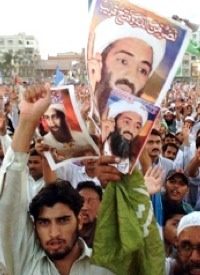
U.S. troops in Afghanistan serve as part of two military operations. Approximately 28,000 U.S. troops are part of Operation Enduring Freedom (OEF) — a U.S. combat operation receiving some support from some coalition partners that currently operates mainly in the eastern and southern parts of Afghanistan along the Pakistan border. The stated purpose of the invasion, which began just a month after 9/11, was to capture terrorist leader Osama bin Laden, destroy his al-Qaeda terrorist organization, and remove the Taliban regime, which had provided a safe sanctuary for al-Qaeda.
The other operation is the NATO-led International Security Assistance Force (ISAF), which was authorized by the United Nations Security Council on December 20, 2001. As with all such international forces serving at the pleasure of the UN, the United States provides the bulk of the troops, currently more than 26,000. The next-largest force in ISAF, provided by the UK, is 8,300 troops.
But in 2003, the main thrust of U.S. “anti-terrorist” military operations became diverted to Iraq, where military operations have recently begun winding down. No evidence of a link between the al Qaeda terrorists and the regime of the former Iraqi dictator Saddam Hussein has even been found.
Almost eight years after 9-11, as the buildup of U.S. and its allied forces in Afghanistan resumes, Osama bin Laden has not been captured and the other goals set back in 2001 have not been accomplished. While a coalition of Afghani anti-Taliban Northern Alliance forces and NATO troops successfully unseated the Taliban from power in the capital and major cities, Taliban-backed al-Qaeda organizations retain a strong presence in outlying areas of the country. On October 1, 2008, General McKiernan warned of a worsening situation in Afghanistan, because the international forces had insufficient troop strength to hold territory they had previously cleared of Taliban influence.
While the U.S. military steps up the campaign in Afghanistan that had long been neglected in favor of operations Iraq, the Taliban have establish strongholds in Pakistan. The militants control about 70 percent of Malakand region, which is just 100 miles from Islamabad, Pakistan’s capital. The government of Pakistan announced on February 16 that it had agreed to accept a system of strict Islamic law, or sharia, in the Malakand region of Pakistan’s North West Frontier Province (NWFP) — which includes the Swat Valley — as well as a suspension of military operations in the area. The agreement effectively abandoned parts of northwest Pakistan to the Taliban insurgents, creating a sanctuary from which they can further threaten supply lines supporting the NATO military operation in Afghanistan. Taliban insurgents have also used the area as a base from which to launch attacks against U.S. and NATO forces in Afghanistan.
As part of the agreement to allow the Taliban to establish Islamic law in the region, the Taliban promised to end insurgent violence and disarm. But when the Taliban broke the agreement, Pakistani troops launched an offensive against the Taliban in April. Voice of America (VOA) reported on May 5 that “hundreds of panicked residents were seen leaving Swat Valley’s main town Tuesday, after the military said militants were patrolling parts of the town and had fired on security forces.”
The shift of the Taliban’s power base from Afghanistan to Pakistan has complicated U.S. efforts to neutralize Taliban support of al Qaeda militants. An article in the New York Times for May 5, “Pakistan Overshadows Afghanistan on U.S. Agenda,” commented on President Obama’s plan to make the elimination of al Qaeda a top priority by sending 21,000 more troops to Afghanistan and to spend billions of dollars on development programs in the region. The Times reporter noted, however:
There was only one hitch: Al Qaeda doesn’t really live in Afghanistan. It survives largely over the border in Pakistan, where American boots on the ground will never be tolerated. “This is the logical flaw in an otherwise pretty sophisticated plan,” one of the participants in the White House debate said at the time. “We have to stabilize Afghanistan. But if the goal is to take out Al Qaeda and its friends, we’re putting our troops in the wrong country.”
The report also quoted Bruce Riedel, the Brookings Institution scholar who served as a co-author of Mr. Obama’s review of the Afghan situation: “The possibility is now real that we will see a jihadist state emerge in Pakistan — not an inevitable outcome, not even the most likely, but a real possibility. And that is the real strategic nightmare for the United States.”
With al-Qaeda safely ensconced within Pakistan, the United States is in the position of trying to destroy an enemy occupying a position in territory that belongs to a supposed ally. The only way our military has to strike back at Taliban positions without actually entering the country is to use unmanned drone aircraft, a practice that has come under much criticism from Pakistanis, because of the inevitable collateral damage.
In another New York Times article published on May 5, “Porous Pakistani Border Could Hinder U.S.,” the writer observed: “If Taliban strategists have their way, [U.S.] forces [in Afghanistan] will face a stiff challenge, not least because of one distinct Taliban advantage: the border between Afghanistan and Pakistan barely exists for the Taliban, who are counting on the fact that American forces cannot reach them in their sanctuaries in Pakistan.”
The problem of fighting enemies hiding across international borders in sanctuary areas was a major handicap for U.S. forces in both Korea and Vietnam. The insanity and treachery behind the catastrophic policy of giving the Chinese communist troops a privileged sanctuary on the north side of the Yalu River — from which they could launch massive attacks against American soldiers in Korea without fear of retaliation — is legendary.
A similar situation existed in Vietnam, where a strategic offensive against Hanoi would have been a sure approach to victory. But President Johnson — like President Truman before him during Korea — blocked such a path. North Vietnam also became a sanctuary. According to historian Dave Palmer, such fear “protected North Vietnam from invasion more surely than any instrument of war Hanoi could have fielded.”
Korea, Vietnam, Afghanistan. All three military operations were authorized by the UN or its subsidiary agencies and fought under UN rules of engagement. In all three, the enemy hid in safe sanctuaries beyond borders that U.S. troops dared not cross. Our nation lost 33,746 through combat deaths in Korea, 47,424 in Vietnam, 3,741 in Iraq, and — so far — 463 in Afghanistan, where fighting is just beginning in earnest.
The result of these deaths and countless billions of dollars contributing to the bankruptcy of our nation has been: half of Korea is still under communist control; all of Vietnam is under communist control; Iraq is under the control of an assortment of competing forces, but the most dominant force is the government headed by Prime Minister Nouri al-Maliki of the Islamic Dawa Party. The Dawa Party backed the Iranian Revolution and also Ayatollah Ruhollah Khomeini during the Iran-Iraq War and still receives financial support from Tehran. Part of the party’s ideology is that Islamic injunctions are the basis of all legislation and that the legislature may not enact any law that is repugnant to Islam. The government is therefore a theocratic institution beholden not only to Islam, but to a militant form of Shiite Islam acceptable to Iranians.
What will be the final verdict in Afghanistan 10 years, thousands of American deaths, and trillions of dollars from now? No one knows, but the smart money isn’t on a republican form of government friendly to Christians, Jews, or other Westerners.
Photo: AP Images



